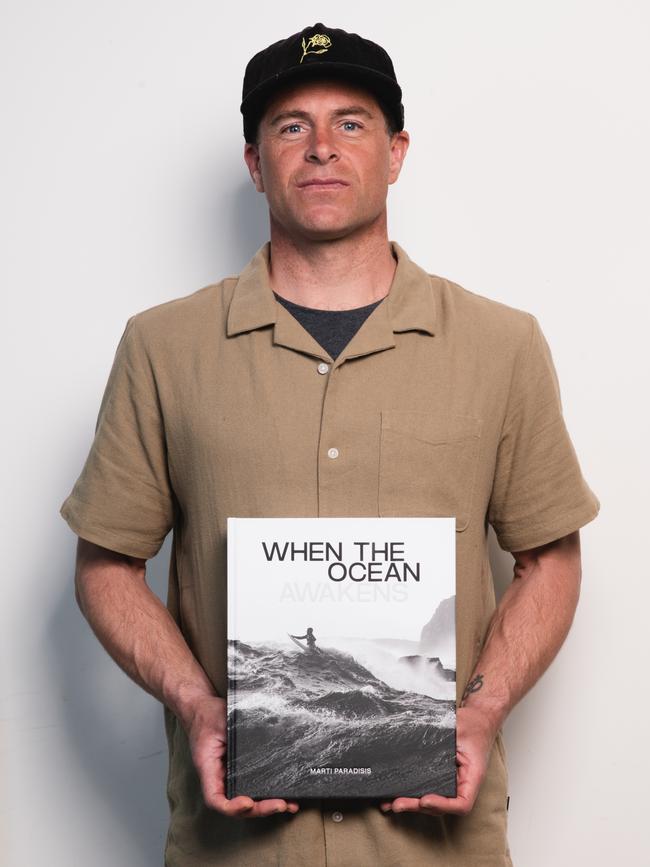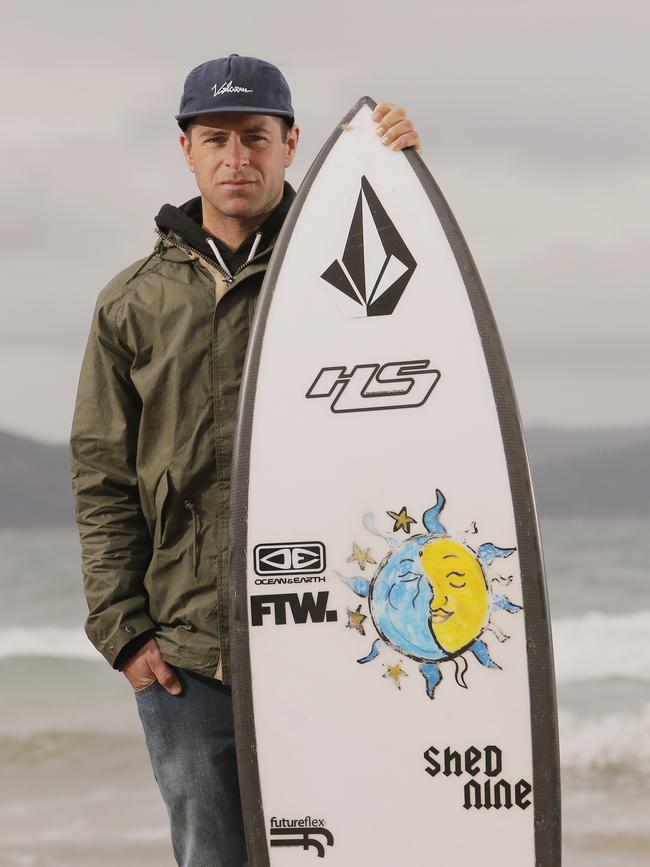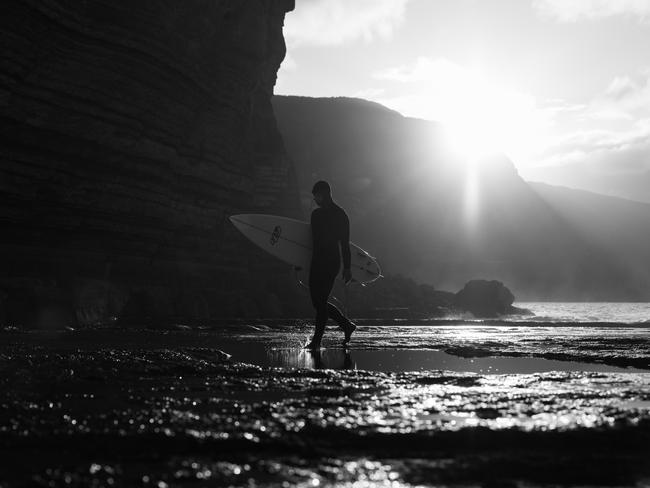Marti Paradisis grew up in Hobart’s Northern Suburbs – a far cry from the sandy shores of Tassie’s surf beaches. Having spent his early childhood consumed by soccer and riding dirtbikes, Paradisis had no idea that once he moved to the quiet coastal town of Clifton Beach that his life would change course forever.
“Our property at Claremont backed onto some bushland, and me and my sister just used to go adventuring up in the bush, running amok – it just felt nice and free, and super quiet,’’ Paradisis, now 41, recalls.
“It’s just where we sort of retreated and hung out most of the time.’’

But during the summer months, that landscape changed, with bush adventures interspersed with plenty of beach antics.
“Summertimes were spent at the beach,’’ Paradisis recalls.
“My parents would always take us to the beach in summer, whether that be up the East Coast, or down to Clifton or Dodges Ferry.’’
Like many kids, Paradisis enjoyed mucking around on a bodyboard, but when his older sister, Brigitte, got a surfboard, he decided to have a go.
And it was an experience that was ultimately life changing.
“My sister actually got a surfboard before me,’’ he explains.
“She used to surf and she was pretty good at it. And it was probably one day, when I was roughly around 10, that I just borrowed her surfboard and started using it. I finally stood up and got that feeling – and that’s where it all started.’’


However, he admits he “wasn’t hooked straight away”, continuing with bodyboarding for another couple of years before he found his way back to stand-up surfing. But once he got into it – and his family relocated to Clifton Beach when he was 15 – his passion for surfing skyrocketed.
Suddenly, instead of hitching rides to the beach from Claremont, or being stuck at home dreaming of the beach on sunny days, or skateboarding around the suburbs while pretending he was surfing, Paradisis had the beach on his doorstep.
“Once we moved down to the beach my life changed forever,’’ Paradisis recalls.
He has since gone on to surf some of the world’s largest and wildest waves, dedicating much of his life to big wave surfing.

He has won multiple big wave surfing awards – the highlight was picking up $20,000 in the Surfing Life Oakley Big Wave Awards in 2013 after riding a monster near Pedra Branca off Tasmania’s South-East Cape. Heart-stopping photos and videos of his daredevil surfing – at locations including Shipstern Bluff, on the Tasman Peninsula – have appeared in newspapers, magazines and on TV stations across the globe. Paradisis was also part of the team of Tassie surfers that introduced world-renowned wave riders Ross Clarke-Jones and Tom Carroll to surfing Pedra Branca in 2008.
And while Paradisis is still passionate about life on the water – and still takes on plenty of monster waves – he has spent the past three years focusing on a new surf-related passion – releasing a visually-stunning book titled When The Ocean Awakens.
The 220-page hardcover coffee table book is a compelling anthology of first-hand stories from Paradisis and other Tasmanian big wave surfers as well as bodyboarders, photographers and fishermen.
Together, they recount their relentless pursuit of some of the world’s most remote and dangerous waves, including the iconic Shipstern Bluff, Governor Island off the East Coast and the treacherous Pedra Branca, a wave breaking 30km off Tassie’s southern coast in the open ocean.
These waves challenge the world’s most elite surfers, but thanks to experience and skill gained over years of dedication, Paradisis says “our local crew stands at the pinnacle of the sport at these locations, continually pushing the limits with every swell”.
The book is packed with adventure, camaraderie, life-and-death challenges, triumphs, and heartbreak, which Paradisis has cleverly brought to life in a way that stays authentic to the character of each of the personalities he profiles.


Paired seamlessly with breathtaking surfing and landscape photography, the stories showcase Tasmania’s natural beauty and take readers on a thrilling ride through three generations of surfing in our island state.
The book was three years in the making. Paradisis spent about a year conducting and transcribing interviews and says all who feature in the book are people who have been part of his surfing journey, who have “inspired me and pushed me” – from those who were pivotal in the early days of his surfing career to those who still have a role in his life to this day.
It took a further 6-12 months to source all the images for the book, and then Paradisis worked with Tasmanian editor Simon de Salis and Tasmanian designer Katie Roberts to help make his vision for the self-published book a polished reality.
It was a steep learning curve for Paradisis, who has never done anything like this before, but he says he has enjoyed the challenge.

The process also took him back to his childhood, when he had a keen interest in creative writing.
“I’d always liked writing, especially in primary school, I’d write stories all the time, and I got really into poetry,’’ he reveals.
“When I was bored at home I’d just write poems and short stories.’’
Although Paradisis admits writing – and school – did take a bit of a back seat once he discovered surfing.
After finishing Year 10 at Cosgrove High School just before moving to Clifton Beach, Paradisis then started at Rosny College.
“Unfortunately that wasn’t a good thing for my schooling,’’ he admits.
“Up until that point I’d done pretty good at school. But there’s that little bit of freedom at college and you can take advantage of that. To my mum’s disappointment, my time at school sort of diminished and I just started surfing flat out. I’d go on the bus to school, and then I’d get off the bus (at college) and I’d hitch a ride straight home if the surf was good. When the surf was good I couldn’t not surf. It was just so embedded in my brain that I couldn’t miss out. And my passion and my thirst for getting good waves grew from there.’’
Despite the distraction, Paradisis served his two years at college and it was here that he met many of the like-minded friends he still surfs with today, including photographers Stu Gibson and Andrew Chisholm.
Paradisis began seeing photos and footage of Tassie surf spots he longed to visit and once his mates started getting cars and licences there was “never a day when someone wasn’t keen to go chasing surf somewhere’’.
“We were just on the hunt for surf flat out,’’ he says.

It was around this time that Paradisis was sponsored by major surf label Volcom – one of his Clifton Beach neighbours was a sales rep for the brand and had been impressed by what he’d seen of Paradisis surfing, eventually approaching the beach-loving teen in the carpark after a surf and offering him a deal.
“That was another huge, pivotal moment in my life,’’ Paradisis recalls.
“Because you’ve got to imagine, this kid from the northern suburbs who’d really only just started surfing and had only just moved to the coast – surfing was quite new, but I had so much passion and energy for it. So to get a sponsor, I just couldn’t believe it, it was unfathomable. And it just gave me so much more motivation to do well at surfing.’’
Paradisis says he was never much good in traditional surfing competitions, “because all I wanted to do was go big and try aerial manoeuvres” which didn’t really fit with the judging criteria.
“I was always a bit of an oddball, I suppose,’’ Paradisis says.

“I wasn’t really welcomed into the surf scene at the start. Until I found my people, and then I didn’t really care. Once I had my crew I didn’t really care about anyone else, I just went about doing what I wanted to do and achieving goals that I wanted to achieve.’’
As much as he’s loved surfing some of the biggest and most remote waves in history, Paradisis says his love of surfing is actually less about the waves he catches and more about satisfying his hunger for adventure.
Surfing big waves requires plenty of precision planning. From monitoring weather forecasts to pinpoint the perfect conditions, to assembling a crew of surfers, photographers and jetski drivers for tows. Sometimes bushwalks or boats are required to get the surfers where they need to go. Then of course they need various boards and wetsuits and safety gear. They need fuel, they need food, they need first-aid gear. They need to be fit and have mastered breath-holding techniques. And they need to mentally prepare themselves for the mega waves they are planning to tackle and the inherent danger they’re exposing themselves to.
“The whole big wave passion didn’t come from wanting to surf big waves in general, it came
from a thirst for adventure,’’ Paradisis explains.


“Ever since I was a kid, when I used to walk in the bush and go exploring, it was embedded in me, I always thrived on adventure, I always loved the idea of organising all my gear and planning where to go and who I was going to go with. There’s more to it than just going out and surfing waves.’’
Although he admits the adrenalin is also part of the thrill.
“Initially it was just the adventure,’’ Paradisis says.
“But then once I started surfing these big waves I realised the thrill it was giving me, I realised the adrenalin – and I realised I liked it.
“All of a sudden I had this passion for adventure, and a passion for bigger surf, I wanted to get that hit of adrenalin, and the crew I was surfing with were on the same program.’’
He was about 18 when Shipstern Bluff started attracting global attention, as one of the wildest and most dangerous surf spots in the world.
Paradisis still remembers the day a neighbour showed him footage of the break.
“I couldn’t believe what I’d seen,’’ he recalls.
“I couldn’t believe this wave existed and it was in Tasmania.’’
He first paddled out at Shipstern when he was about 19. He didn’t catch a wave initially, he was just keen to watch others surf it and scope out of the area and slowly he built up to being mentally ready to make his Shipstern surfing debut.
“I paddled out – I just wanted to feel the energy of the place,’’ Paradisis says.
“It was so spectacular, I’d never seen anything like it. Everything down there is huge – the cliffs are huge, the waves are huge, the boulders are huge. Once I started surfing it I couldn’t get enough of it, I just wanted to be there every time it broke.’’
Back then they didn’t have access to as much forecasting data as they do now, and were just “winging it” a lot of the time.

Professional surfers and photographers would fly in from interstate and overseas, with surfers towed in on jetskis to ride the monster waves. And a couple of months later Paradisis and his friends would see those images appearing in surfing magazines all over the world.
So they decided to step up their game.
“We thought ‘this is in our backyard, we should be the ones out there pushing the limits, we should be the ones out there getting good waves and getting the photos in the magazines,’’ Paradisis says.
“That was a big driver for us to go out there and push ourselves to be the best. Shipstern was blowing up in all the surfing mainstream media and we wanted to make an impact on that, and that’s what we did. We were a really lucky generation. We were super lucky when we came onto the scene that Shipstern was making international headlines and we just happened to tap into that. We were able to take advantage of the money getting thrown around in the surf industry at that time, and the hype around Shippies and slab surfing in general. Surfing waves like this – back then it was really new, hardly anyone in the world was surfing these types of waves.’’


Paradisis worked a variety of odd jobs – in retail and surf stores, as a labourer, as a landscaper, as a car detailer, as a water tank deliverer and as a pool lifeguard – he even inserted catalogues into The Mercury newspaper at night, so he could surf during the day.
“I’ve had so many jobs over the years, it’s been crazy,’’ he says.
“But that was the lifestyle I picked, I worked to earn money for surfing.’’
He was one of the first people to surf Pedra Branca – he “lucked into” being the first of his crew to catch a wave out there during the documented trip with Ross Clarke-Jones and Tom Carroll.
“For me that was such a huge thing,’’ he says.
“Not only to be part of a team that pioneered a wave of such significance, but to have ridden the first wave ever caught out there.’’

Paradisis is now somewhat of a veteran, offering advice to young surfers coming through the ranks.
“It’s a weird thing because I don’t feel old one single bit – only at 6am in the morning when I wake up (and the body is stiff) – other than that my brain still feels like I’m 18,’’ he says.
“But I’ve probably got a lot of knowledge and I love to share it with younger generations.’’
Paradisis says passing down stories and knowledge is an important part of his book.
“The book came about because my friends and I had done so much over the years, we’d gone on so many adventures and achieved things, and been in so many crazy situations,’’ he explains.
“I personally really enjoy reading real-life stories and reading history – I’ve got a real passion for that – so it was sort of my driver to do this book, I wanted to interview all my friends and find out the most pivotal, life-changing moments in their surfing journey. Those unique experiences put into a book with world-class imagery, also from friends, is just something I’ve always dreamed of.’’
It’s not just a book for surfers though – Paradisis believes the book is a great showcase of
Tasmania which will appeal to both locals and tourists, regardless of whether they have ever surfed or not.
“All the surfers are Tasmanian, all the photos are taken by Tasmanians, and all the surf spots are Tasmanian,’’ he says.
“This is a full-blown Tassie book, everything about it is connected to our island.’’
The layout invites readers to either read the book from cover to cover, or simply flip to any page and be drawn in by the powerful imagery and stories.
Paradisis says receiving his first copy of the book earlier this month was a surreal experience.
“For this to be the first book I’ve ever published and to finally get a copy delivered to my door and open it up and see it – it’s something I’m just so proud of,’’ he says.
“I just really hope everyone who is part of this book is proud of it too. And I really hope anyone who gets their hands on it appreciates what they read and what they see – it’s a beautiful book.’’
Appreciation is also something Paradisis is mindful of when he’s surfing those monster waves.
“A really big part of it is appreciation,’’ he explains.
“You’re appreciating the effort and energy put into getting into this position in the first place. You also take a minute to look around you and appreciate where you are and what you’re doing at this time in life. We go to some of the most beautiful and remote places on the planet, where hardly anyone has ever been before, and if you don’t take that time to just sit back and appreciate it, you’re not doing your own life justice. You’re letting this beautiful moment go and you’ll potentially never get it back. That’s as important as going out there and catching a wave.’’
It might sound tranquil, but Paradisis hasn’t escaped unscathed from his decades of risk-taking.
He’s had “a lot of knockouts, a lot of concussions, a lot of broken bones” and “a lot of ligament and tendon-type damage … my body is riddled with pain and injuries,’’ he says.

He still lives at Clifton Beach, around the corner from his mum and dad, with his partner Jaymie and their two-year-old daughter.
And he’s still as passionate about surfing as ever.
“I live for it still,’’ Paradisis says.
“I’m definitely not as gung-ho as I used to be. But I still love going down there (to Shipstern Bluff), I still love the sense of adventure, I’m always keen to jump on adventure. And I still love watching what my mates do – they are just as crazy as ever.’’ •
When the Ocean Awakens, by Marti Paradisis ($90), is available from Salamanca Market (Paradisis is running a casual stall there), local bookstores and online at whentheoceanawakens.com and @whentheoceanawakens on Instagram.


Add your comment to this story
To join the conversation, please log in. Don't have an account? Register
Join the conversation, you are commenting as Logout
Soak up the serenity at Huon Valley bush retreat
The Instagram-worthy mineral hot tub is an obvious drawcard, allowing guests to soak away stress, surrounded by nature. But Orchards Nest has plenty more to offer guests, writes Linda Smith
NoHo’s newest eatery will help you spice up your life
This latest addition to the North Hobart restaurant scene, a sibling to Sawak in the CBD, offers diners a taste of the magical fusion of flavours known as ‘Nyonya’ cuisine, writes Alix Davis